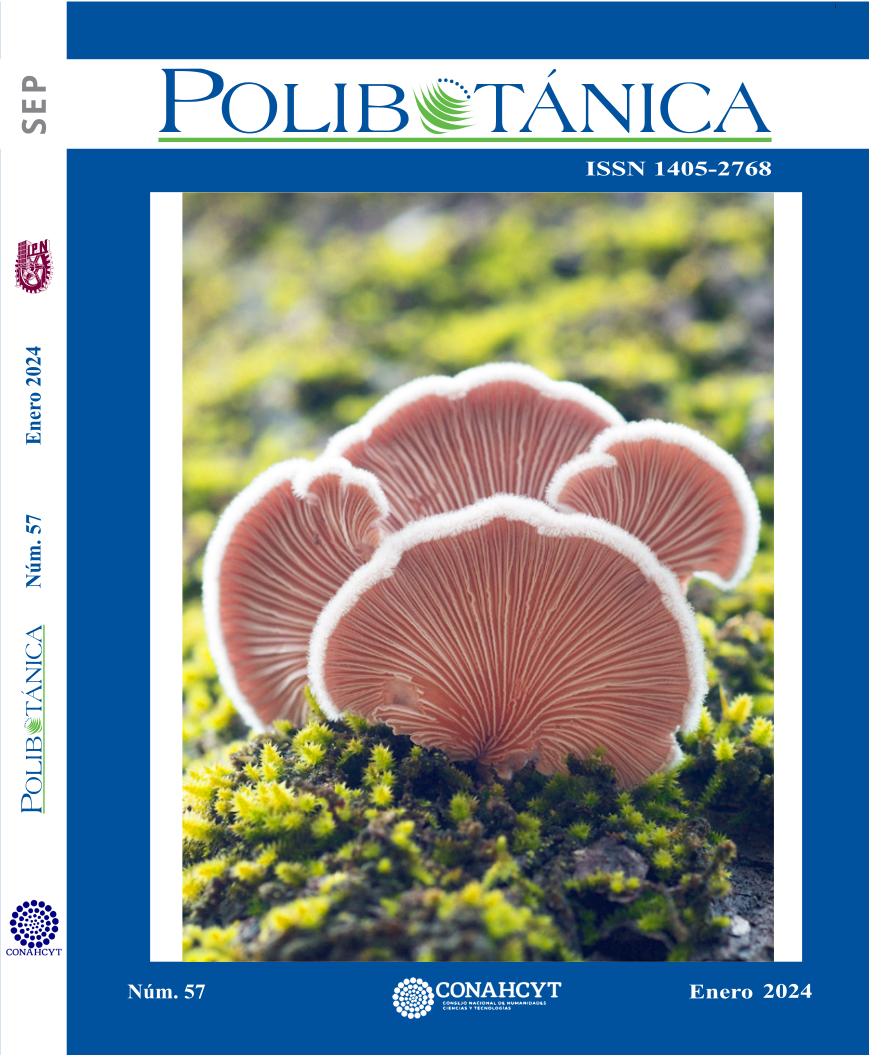Medium-term in vitro conservation of vanilla (Vanilla planifolia Andrews | Orchidaceae)
DOI:
https://doi.org/10.18387/polibotanica.57.8Keywords:
Abscisic acid, Chlormequat chloride, Reduced growthAbstract
Vanilla planifolia Andrews is a species subject to ecological, biological, social, and economic pressures that are affecting its cultivation, natural populations, genetic diversity, and viability, therefore, it is necessary to create conservation strategies that implicate the development of novel, viable, and affordable technological tools such as medium-term in vitro conservation using growth inhibitors, these compounds delay growth, allowing longer intervals between subcultures, reducing costs maintaining the capacity to reactivate or recover growth rates when it´s needed.
In Mexico, scientific research on medium-term in vitro cultivation an conservation of Vanilla is scarece, and there are no reports about effects of interaction between abscisic acid (ABA) and chlormequat chloride (CCC). In this sense, the present study is aimed to determine the effect of the interaction of different concentrations of ABA (0, 1.5, 3 mg L-1) and CCC (0, 1, 2, 4, 6 mg L-1) added to medium Murashige & Skoog (MS) at 75% on morphogenesis and survival percentage in the in vitro culture of Vanilla planifolia Andrews, culturing microshoots of 1.5 cm length for a period of 200 days, after which the total length of the seedlings, number of shoots, leaves, roots, and survival percentage were evaluated.
In the treatments, symptoms of calcium deficiency were found in treatment 04, while nitrogen deficiency symptoms due to nutrient depletion in the culture medium were observed in the Control treat. The rest of the treatments did not generate negative effects on the phenotype of the seedlings. The lowest values were observed in treatment 14, mean of 1.80 cm total length, 0.27 shoots, 1.83 leaves, and 1.50 roots, and a survival rate of 72%. On the other hand, treatment 12 had the best characteristics, showing no morphological anomalies and high survival rates, with 1.90 cm total length, 0.44 shoots, 1.88 leaves, 1.64 roots, and a 100% survival rate. Additionally it is statistically similar to treatment 14, indicating that the combination of regulators had a synergistic effect, allowing for medium-term in vitro conservation of Vanilla planifolia. Therefore, it can be considered as a tool for establishing in vitro germplasm banks.
References
Azofeifa-Bolaños, J. B., Paniagua-Vásquez, A., & García-García, J. A. (2014). Importancia y desafíos de la conservación de Vanilla spp. (Orquidaceae) en Costa Rica. Agron. Mesoam, 25(1), 189–202. https://www.redalyc.org/articulo.oa?id=43730495019
Barrueto, L. P., & Carvalho, C. B. (2008). Importance of abscisic acid (ABA) in the in vitro conservation of cassava (Manihot esculentus). Chil. J. Agric. Res, 68(3), 304–308. https://doi.org/http://dx.doi.org/10.4067/S0718-58392008000300011.
Bello-Bello, J. J., García-García, G. G., & Iglesias-Andreu, L. (2015). Conservación de Vainilla (Vanilla planifolia Jacks.) bajo condiciones de lento crecimiento in vitro. Rev. Fitotec. Mex, 38(2), 165–171. https://www.redalyc.org/articulo.oa?id=61038806006
Bello-Bello, J. J., Morales-Ramos, V., & Gómez-Merino, F. C. (2014). Conservación de recursos genéticos de Caña de azúcar (Saccharum spp.). Agro Productividad, 7(2), 42–46. https://revista-agroproductividad.org/index.php/agroproductividad/article/view/513
Bonilla, M. M., Mancipe, C., & Aguirre, A. C. (2015). Conservación in vitro: una perspectiva para el manejo de los recursos fitogenéticos. Rev. Invest. Agra. Amb, 6(1), 67–82. https://doi.org/https://doi.org/10.22490/21456453.1264
Bory, S., Grisoni, M., Duval, M. F., & Besse, P. (2008). Biodiversity and preservation of vanilla: present state of knowledge. Genet. Resour. Crop Evol, 55(4), 551–571. https://doi.org/10.1007/s10722-007-9260-3
Coelho, N., Gonçalves, S., & Romano, A. (2020). Endemic Plant Species Conservation: Biotechnological Approaches. Plants, 9(3), 345. https://doi.org/10.3390/plants9030345.
da Silva, T. L., & Scherwinski Pereira, J. E. (2011). In vitro conservation of Piper aduncum and Piper hispidinervum under slow growth conditions. Pesq. Agropec. Bras, 46(4), 384–389. https://www.scielo.br/j/pab/a/KVJ4xHcKZtqZzmqVpWRv4Ms/?lang=en&format=pdf
Engelmann, F. (2011). Use of biotechnologies for the conservation of plant biodiversity. In Vitro Cell. Dev. Biol.-Plant, 47, 5–16. https://doi.org/10.1007/s11627-010-9327-2
Hussain, I., Chaudhry, Z., Muhammad, A., Asghar, R., Naqvi, S. M., & Rashid, H. (2006). Effect of chlorocholine chloride, sucrose and BAP on in vitro tuberization in potato (Solanum tuberosum L. CV.Cardinal). Pak. J. Bot, 38(2), 275–282. https://www.researchgate.net/publication/267416286_Effect_of_chlorocholine_chloride_sucrose_and_BAP_on_in_vitro_tuberization_in_potato_Solanum_tuberosum_L_cvCardinal
Kozak, D. (2006). The effect of growth retardants applied In vitro on the acclimatization and growth of Tibouchina urvilleana cogn. In vivo. Acta Sci. Pol. Hortorum Cultus, 5(1), 65–70.
Lozano-Rodríguez, M. A., Menchaca-García, R. A., Alanís-Méndez, J. L., & PechCanché, J. M. (2015). Cultivo in vitro de yemas axilares de Vanilla planifolia Andrews con diferentes citocininas. Rev. Cient. Biol. Agropec. Tux, 4(6), 1153–1165. https://www.researchgate.net/publication/293556691_Cultivo_in_vitro_de_yemas_axilares_de_Vanilla_planifolia_Andrews_con_diferentes_citocininas
Maldonado-Torres, R., Álvarez-Sánchez, M. E., Abarca-Cervantes, A. D., & Almaguer-Vargas, G. (2020). Cambios celulares en hojas de aguacate con deficiencias de calcio. Rev. Mex. Cienc. Agríc, 11(1), 13–23. https://www.scielo.org.mx/scielo.php?script=sci_arttext&pid=S2007-09342020000100013
Matsoukis, A., Gasparatos, D., & Chronopoulou-Sereli, A. (2015). Impact of shading and chlormequat chloride on Lantana specific leaf area and mineral content. J. Anim. Plant Sci, 25(5), 1371–1376. https://www.researchgate.net/publication/283459453_Impact_of_shading_and_chlormequat_chloride_on_Lantana_specific_leaf_area_and_mineral_content
Menchaca, R. A., & Lozano, M. A. (2018). Importancia de la Conservación ex situ de un cultivo amenazado: la vainilla. In E. Silva-Rivera, V. Martínez-Valdés, M. Lascurain, & E. Rodríguez-Luna (Eds.), De la recolección a los agroecosistemas soberanía alimentaria y conservación de la biodiversidad (pp. 253–267).
Páez, J., & González, R. (2001). Conservación In Vitro de Dos Variedades de Papa (Solanum tuberosum L) Bajo Condiciones de Crecimiento Mínimo. Rev. Latinoam. Papa, 12, 121–129. http://ojs.papaslatinas.org/index.php/rev-alap/article/view/113/116
Pérez, E., Esparza, M. J., & Pérez, M. E. (2012). Conservación in vitro de germoplasma de Agave spp. Bajo condiciones de crecimiento retardado. Rev. Fitotec. Mex, 35(4), 279–287. https://www.scielo.org.mx/scielo.php?script=sci_arttext&pid=S0187-73802012000400004
Ray, A., & Bhattacharya, S. (2008). An improved micropropagation of Eclipta alba by in vitro priming with chlorocholine chloride. J. Plant Biotechnol, 92, 315–319. https://doi.org/10.1007/s11240-007-9328-y
Reed, B. M., Sarasan, V., Kane, M., Bunn, E., & Pence, V. C. (2011). Biodiversity conservation and conservation biotechnology tools. In Vitro Cell. Dev. Biol.-Plant, 47, 1–4. https://doi.org/https://doi.org/10.1007/s11627-010-9337-0
Rivera-Calderón, A. L., Valbuena-Benavides, R. I., Hidalgo-Hidalgo, R., & Moreno- Mendoza, J. D. (2008). Microtuberización in vitro de siete accesiones de papa de la colección central colombiana. Acta Agron (Palmira), 57(3), 175–180. https://www.redalyc.org/articulo.oa?id=169913320004
Sánchez-Chiang, N., & Jiménez, V. M. (2010). Técnicas de conservación in vitro para el establecimiento de bancos de germoplasma en cultivos tropicales. Agron. Mesoam, 21, 193–205. https://www.scielo.sa.cr/scielo.php?pid=S1659- 13212010000100020&script=sciabstract&tlng=es
Silva-Garza, M. A., Gámez-González, H., Zavala-García, F., Cuevas- Hernández, B., & Rojas-Garcidueñas, M. (2001). Efecto de cuatro fitorreguladores comerciales en el desarrollo y rendimiento del girasol. Ciencia UANL, 4(1), 69–75. http://eprints.uanl.mx/id/eprint/1066
Yun-peng, D., Wen-yuan, L., Ming-fang, Z., Heng-bin, H., & Gui-xia, J. (2012). The establishment of a slow-growth conservation system in vitro for two wild lily species. Afr. J. Biotechnol, 11(8), 1981–1990. https://doi.org/10.5897/AJB11.2868
Zakaria, M., Hossain, M. M., Khaleque-Mian, M. A., Hossain, T., & Uddin, M. Z. (2008). In vitro tuberization of potato influenced by benzyl adenine and chloro choline chloride. Bangladesh J. Agril. Res, 33(3), 419–425. https://doi.org/10.3329/BJAR.V33I3.1601
Downloads
Published
Issue
Section
License

Polibotánica by Departamento de Botánica de la Escuela Nacional de Ciencias Biológicas del Instituto Politécnico Nacional se distribuye bajo una Licencia Creative Commons Atribución-NoComercial-CompartirIgual 4.0 Internacional.




















